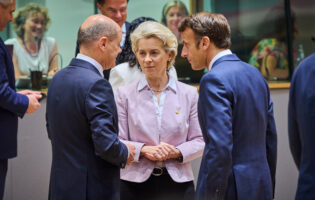Germany is One of America’s Most Important European Allies, the Next President Must Understand Why

Rachel Rizzo
Center for a New American Security
Rachel Rizzo is the Research Associate for the Strategy and Statecraft Program at the Center for a New American Security (CNAS). Her work focuses on U.S. foreign policy and defense strategy, geopolitics, NATO and Europe. Prior to joining CNAS, Ms. Rizzo worked on the Strategy Initiative at the Atlantic Council’s Brent Scowcroft Center on International Security. She also has previous work experience with Goldman Sachs, the Office of the Under Secretary of Defense for Policy, the National Defense University, and the U.S. Mission to NATO. Her writing has appeared in Politico Europe, Defense One, Defense News, the Hill, the National Interest, and War on the Rocks. Ms. Rizzo received her M.A. in Security Policy Studies from the George Washington University’s Elliott School of International Affairs where she focused on Defense Analysis and Homeland Security Policy. She graduated from the University of Utah in 2010 with a B.A. in Finance.
She is a 2016-2017 participant in AICGS’ project “A German-American Dialogue of the Next Generation: Global Responsibility, Joint Engagement,” sponsored by the Transatlantik-Programm der Bundesrepublik Deutschland aus Mitteln des European Recovery Program (ERP) des Bundesministeriums für Wirtschaft und Energie (BMWi).
The transatlantic community is understandably concerned about the shocking election of Donald J. Trump as the next U.S. president. It is an outcome that no one saw coming—not even experts in the United States. Now, we must wait to see if his governance style matches the bombastic style in which he campaigned. In the meantime, between now and January 20, Trump will name his new cabinet, and that could give us a good idea of where the Trump administration will place Europe on its list of priorities. The U.S.-German relationship is a keystone of the transatlantic relationship, and we must ensure the incoming president and his cabinet know precisely why this particular bi-lateral relationship must continue to be strengthened.
First, President-elect Trump must understand just how the U.S.-German relationship has evolved since the end of the Cold War. Since the fall of the Berlin Wall and the subsequent dissolution of the Warsaw Pact, the United States and Germany have worked hand-in-hand to address global issues. Germany in particular has shown immense dedication to the strength of this relationship even when the two sides take vastly different approaches to the issue at hand. For example, Germany emphatically disagreed with the post 9/11 U.S. interventions in the Middle East, but still contributed to the ISAF mission in Afghanistan. Many Germans think the United States is too tough on Russia, but Germany still voted to renew a vast sanctions regime against Russia. And many Germans disagree with the fundamental pillars of the Transatlantic Trade and Investment Partnership (TTIP), but German leadership is still at the table trying to negotiate a solution. They’ve made it clear that a strong relationship with the Untied States is important to them, and they’ve gone through the effort to prove it.
Second, the incoming administration must recognize the strides Germany is taking to play a more active role on the world stage. For example, even though it has a vastly different approach to defense policy than the United States and some of its European partners, it is still heeding calls from the international community to try to spend 2 percent of its GDP on defense. Currently, Germany plans to hike defense spending by 6.8 percent for 2017 (or €1.7 billion). Furthermore, after planning to continue defense spending increases for 2018 and 2019, Germany plans to dedicate €39.18 billion for defense in 2020. Although this still only translates to around 1.2 percent of GDP (well-below the stated 2 percent goal), this highlights a deeper issue, which is that gauging the strength of an ally by what percentage of GDP it spends on defense is far too simplistic. Germany is a good example of why it might be time to seriously rethink that measurement.
Third, since the end of the Cold War, Germany has been a bastion of liberal values in Europe. The past couple years have been rocky ones for Europe—from the Brexit vote in late June, to the migration crisis, to the rise of far-right parties and rejection of liberalism by swaths of the European populace. The U.S. could look to Germany to see the right way to handle an uncertain future. Merkel’s handling of the refugee crisis is a perfect example of why: Although she was harshly criticized for her “open door” policy toward refugees, she has staunchly defended it because morally it is the right thing to do. The country welcomed almost one million asylum seekers in 2015 alone, citing Germany’s “value and social order.” The United States could take a page out of Germany’s book in this regard.
We are living in uncertain times, and the election of Donald Trump proves that the United States is experiencing much of the same type of uncertainty as Europe. Although we must wait and see where the next administration places Europe on its priority list, they must understand that it would be unwise to let this relationship fray or falter. Europe and the United States are each others closest partners, and the German-U.S. relationship is an extension of that. We must work harder than ever to ensure Germany stays high on the radar of the next president.








